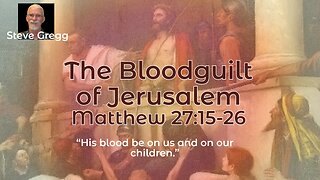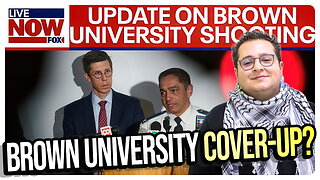Premium Only Content

Ezra 7-8 - Artaxerxes' Decree, Returnees to Jerusalem - Steve Gregg
https://www.thenarrowpath.com | Ezra Chapter 7
In this chapter, Gregg highlights Ezra’s introduction as a pivotal figure—a priest and scribe skilled in the Law of Moses. The narrative shifts to a later period, about 60 years after the events of chapter 6, under the reign of the Persian king Artaxerxes I (circa 458 BC). Ezra is commissioned by Artaxerxes to return to Jerusalem with a group of exiles, bringing offerings and resources to support the temple. Gregg emphasizes the following:
Ezra’s Qualifications: Ezra is described as a scribe with deep knowledge of God’s law, making him a suitable leader for spiritual reform. His lineage from Aaron underscores his priestly authority.
Royal Support: Artaxerxes provides a letter granting Ezra authority to teach the law, appoint judges, and enforce it, along with generous provisions (silver, gold, and temple supplies). Gregg notes this as an extraordinary example of God’s providence, using a pagan king to advance His purposes.
Purpose of the Mission: Ezra’s task is to beautify the temple and ensure proper worship, but more crucially, to teach the people the law, fostering a renewed covenant relationship with God.
Spiritual Insight: Gregg points out Ezra’s gratitude in verses 27-28, where he praises God for “putting it in the king’s heart” to support the mission, reflecting Ezra’s recognition of divine sovereignty.
Gregg also discusses the historical context, noting the absence of Zerubbabel and Jeshua from earlier chapters, suggesting they had likely died by this time. He portrays Ezra as a second-wave leader in the restoration of Judah, distinct from the initial return under Zerubbabel.
Ezra Chapter 8
Chapter 8 details the logistics of Ezra’s journey and his reliance on God. Gregg breaks this down into practical and theological lessons:
The Census and Preparation: Ezra gathers about 1,500 men (plus families, totaling perhaps 5,000 people) at the Ahava River. Gregg notes the inclusion of specific family names, showing continuity with earlier returns, though some priestly families (e.g., Levites) were initially reluctant to join until Ezra recruits them.
Faith Over Security: A key moment is Ezra’s decision not to request a military escort from Artaxerxes. Having publicly declared trust in God’s protection, Ezra leads the group in fasting and prayer for safety on the 900-mile journey. Gregg sees this as a powerful testimony of faith, especially given the dangers of bandits and the valuable cargo they carried.
God’s Deliverance: The group arrives safely in Jerusalem after four months, with all treasures intact. Gregg underscores this as evidence of God answering their prayers, reinforcing the theme of divine faithfulness.
Worship Restored: Upon arrival, the exiles offer sacrifices and deliver the king’s resources to the temple. Ezra delegates responsibilities to ensure accountability for the treasures, reflecting his administrative wisdom.
Gregg connects these events to broader biblical themes, such as God’s provision for His people and the importance of trusting Him over human means. He also draws a parallel to Christian life, suggesting that believers, like Ezra, should boldly rely on God rather than worldly solutions.
Overall Themes
Across both chapters, Gregg portrays Ezra as a model of godly leadership—combining scholarship, faith, and practical action. He emphasizes God’s sovereignty in orchestrating historical events through unlikely figures like Artaxerxes and Ezra’s unwavering commitment to restoring Israel’s spiritual identity. The teachings encourage reliance on God’s protection and the centrality of His word in community life.
#ezra #artaxerxes #rebuilding #rebuildinglife #rebuildinghope #cyrus_the_great #jerusalem #ezra7 #ezra8 #haggai #zechariah #babylon #exile #prophecy #isaiah #daniel #daniel9 #thenarrowpath #stevegregg #70weeksprophecy
-
 22:28
22:28
The Narrow Path
4 months agoThe Bloodguilt of Jerusalem by Steve Gregg (Matthew 27:15–26)
1352 -
 1:01:23
1:01:23
Nick Freitas
4 hours agoLIVE at America Fest!
37.1K2 -
 1:11:19
1:11:19
vivafrei
5 hours agoCandace Owens' Backtracks? Brown University Cover-Up? Bongino Leaves! Pfizer Makes LEGAL ADMISSIONS?
120K69 -
![[Ep 813] LIVE from Rumble Set at AmFest 2025 | Guests Vem, Midnight, & Kevin Smith](https://1a-1791.com/video/fwe2/31/s8/1/4/F/c/J/4FcJz.0kob-small-Ep-813-LIVE-from-Rumble-Set.jpg) 56:22
56:22
The Nunn Report - w/ Dan Nunn
5 hours ago[Ep 813] LIVE from Rumble Set at AmFest 2025 | Guests Vem, Midnight, & Kevin Smith
41K3 -
 29:58
29:58
Stephen Gardner
5 hours ago🔥IT'S BAD! NEW report just DROPPED!
43.5K33 -
 LIVE
LIVE
LFA TV
21 hours agoLIVE & BREAKING NEWS! | THURSDAY 12/18/25
898 watching -
 1:47:16
1:47:16
freecastle
8 hours agoTAKE UP YOUR CROSS- A man’s heart PLANS his way, but the LORD DIRECTS his steps!
13.2K4 -
 1:03:40
1:03:40
John Crump Live
3 hours ago $0.46 earnedChristmas Special
10.2K -
 54:53
54:53
The Quartering
8 hours agoDan Bongino Quits, New Break In Tyler Robinson Case & Brown Shooting!
135K71 -
 2:12:49
2:12:49
Side Scrollers Podcast
7 hours agoTrans Surgeries For Kids CRIMINALIZED + Harassed Target Employee Speaks Out + More | Side Scrollers
93.1K19